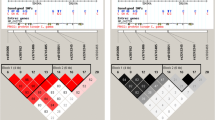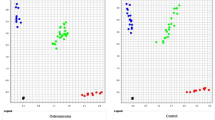Abstract
Osteosarcoma is a common malignant tumor, which exists widely in the bone of children and adolescents. Protein kinase C gamma (PRKCG) gene, which encodes γPKC, plays important roles in tumor promotion, cell proliferation, differentiation, and migration. The objective of the present study was to investigate the relationship between PRKCG polymorphisms and the risk of osteosarcoma. Five tag single nucleotide polymorphisms (SNPs) of PRKCG were retrieved from the HapMap database and genotyped by the method of SNapShot in a hospital-based study containing 388 patients and 388 healthy individuals. Odds ratios (ORs) and their 95 % confidence intervals (CIs) were used to evaluate the association SPSS 20.0 statistical software package was used to analyze statistical data. Our results suggested that the T/C variant of rs454006 located in the intron 3 region of PRKCG gene was significantly associated with an increased risk of osteosarcoma (CC vs. TT, OR = 1.91; 95 % CI 1.29–2.85; P = 0.001; CC vs. TT+TC, OR = 2.14, 95 % CI = 1.48–3.09, P = 0.001; C vs. T, OR = 1.32, 95 % CI = 1.08–1.62, P = 0.008). Similarly, the rs3745406 T/C variant can also elevate the risk of osteosarcoma in the dominant model (OR = 1.45, 95 % CI = 1.08–1.96, P = 0.014), homozygous model (OR = 1.68, 95 % CI = 1.10–2.59, P = 0.002), and allelic model (OR = 1.31, 95 % CI = 1.07–1.61, P = 0.009). However, there were no significant differences in genotypes and allele frequencies of rs2547362 (T>C), rs8103851 (C>G), and rs2242245 (T>C) SNPs between osteosarcoma patients and healthy controls. The results showed that carrier of rs454006*C allele and rs3745406*C might elevate the risk of osteosarcoma. Further studies are needed to validate the coalition between PRKCG gene polymorphisms and risk of osteosarcoma relying on a larger population that included the participants in different ethnicity and hospital.



Similar content being viewed by others
References
Gorlick R, Janeway K, Lessnick S, Randall RL, Marina N. Children's Oncology Group's 2013 blueprint for research: bone tumors. Pediatr Blood Cancer. 2013;60:1009–15.
Geller DS, Gorlick R. Osteosarcoma: a review of diagnosis, management, and treatment strategies. Clin Adv Hematol Oncol. 2010;8:705–18.
Haddox CL, Han G, Anijar L, Binitie O, Letson GD, et al. Osteosarcoma in pediatric patients and young adults: a single institution retrospective review of presentation, therapy, and outcome. Sarcoma. 2014;2014:402509.
Wafa H, Grimer RJ. Surgical options and outcomes in bone sarcoma. Expert Rev Anticancer Ther. 2006;6:239–48.
Goricar K, Kovac V, Jazbec J, Zakotnik B, Lamovec J, et al. Influence of the folate pathway and transporter polymorphisms on methotrexate treatment outcome in osteosarcoma. Pharmacogenet Genomics. 2014;24:514–21.
Wittig JC, Bickels J, Priebat D, Jelinek J, Kellar-Graney K, et al. Osteosarcoma: a multidisciplinary approach to diagnosis and treatment. Am Fam Physician. 2002;65:1123–32.
Kager L, Zoubek A, Potschger U, Kastner U, Flege S, et al. Primary metastatic osteosarcoma: presentation and outcome of patients treated on neoadjuvant Cooperative Osteosarcoma Study Group protocols. J Clin Oncol. 2003;21:2011–8.
Yang LM, Li XH, Bao CF. Glutathione S-transferase P1 and DNA polymorphisms influence response to chemotherapy and prognosis of bone tumors. Asian Pac J Cancer Prev. 2012;13:5883–6.
Bai SB, Chen HX, Bao YX, Luo X, Zhong JJ. Predictive impact of common variations in DNA repair genes on clinical outcome of osteosarcoma. Asian Pac J Cancer Prev. 2013;14:3677–80.
Teng JW, Yang ZM, Li J, Xu B. Predictive role of glutathione S-transferases (GSTs) on the prognosis of osteosarcoma patients treated with chemotherapy. Pak J Med Sci. 2013;29:1182–6.
Nishizuka Y. Intracellular signaling by hydrolysis of phospholipids and activation of protein kinase C. Science. 1992;258:607–14.
Kofler K, Erdel M, Utermann G, Baier G. Molecular genetics and structural genomics of the human protein kinase C gene module. Genome Biol. 2002;3: RESEARCH0014.
Hawkins MM, Wilson LM, Burton HS, Potok MH, Winter DL, et al. Radiotherapy, alkylating agents, and risk of bone cancer after childhood cancer. J Natl Cancer Inst. 1996;88:270–8.
Zhong GQ, Tu RH, Zeng ZY, Li QJ, He Y, et al. Novel functional role of heat shock protein 90 in protein kinase C-mediated ischemic postconditioning. J Surg Res. 2014;189:198–206.
Chen DH, Brkanac Z, Verlinde CL, Tan XJ, Bylenok L, et al. Missense mutations in the regulatory domain of PKC gamma: a new mechanism for dominant nonepisodic cerebellar ataxia. Am J Hum Genet. 2003;72:839–49.
Schlaepfer IR, Clegg HV, Corley RP, Crowley TJ, Hewitt JK, et al. The human protein kinase C gamma gene (PRKCG) as a susceptibility locus for behavioral disinhibition. Addict Biol. 2007;12:200–9.
Klebe S, Durr A, Rentschler A, Hahn-Barma V, Abele M, et al. New mutations in protein kinase Cgamma associated with spinocerebellar ataxia type 14. Ann Neurol. 2005;58:720–9.
Xu Y, Lopes C, Wende H, Guo Z, Cheng L, et al. Ontogeny of excitatory spinal neurons processing distinct somatic sensory modalities. J Neurosci. 2013;33:14738–48.
Parsons M, Adams JC. Rac regulates the interaction of fascin with protein kinase C in cell migration. J Cell Sci. 2008;121:2805–13.
Mochizuki H, Seki T, Adachi N, Saito N, Mishima HK, et al. R659S mutation of gammaPKC is susceptible to cell death: implication of this mutation/polymorphism in the pathogenesis of retinitis pigmentosa. Neurochem Int. 2006;49:669–75.
Boerman I, Selvarajah GT, Nielen M, Kirpensteijn J. Prognostic factors in canine appendicular osteosarcoma - a meta-analysis. BMC Vet Res. 2012;8:56.
Jones KB, Salah Z, Del Mare S, Galasso M, Gaudio E, et al. miRNA signatures associate with pathogenesis and progression of osteosarcoma. Cancer Res. 2012;72:1865–77.
Ogawa K, Seki T, Onji T, Adachi N, Tanaka S, et al. Mutant gammaPKC that causes spinocerebellar ataxia type 14 upregulates Hsp70, which protects cells from the mutant's cytotoxicity. Biochem Biophys Res Commun. 2013;440:25–30.
Wang X, Sun Y, Sun N, Liu W, Lang XE, et al. Association study between protein kinase C gamma gene polymorphism and major depressive disorder. Zhonghua Yi Xue Za Zhi. 2010;90:738–42.
Newton AC. Protein kinase C: structural and spatial regulation by phosphorylation, cofactors, and macromolecular interactions. Chem Rev. 2001;101:2353–64.
Barmack NH, Qian Z, Yoshimura J. Regional and cellular distribution of protein kinase C in rat cerebellar Purkinje cells. J Comp Neurol. 2000;427:235–54.
Hiramoto K, Kawakami H, Inoue K, Seki T, Maruyama H, et al. Identification of a new family of spinocerebellar ataxia type 14 in the Japanese spinocerebellar ataxia population by the screening of PRKCG exon 4. Mov Disord. 2006;21:1355–60.
Vignjevic D, Schoumacher M, Gavert N, Janssen KP, Jih G, et al. Fascin, a novel target of beta-catenin-TCF signaling, is expressed at the invasive front of human colon cancer. Cancer Res. 2007;67:6844–53.
Mazzoni E, Adam A, de Kier B, Joffe E, Aguirre-Ghiso JA. Immortalized mammary epithelial cells overexpressing protein kinase C gamma acquire a malignant phenotype and become tumorigenic in vivo. Mol Cancer Res. 2003;1:776–87.
Griner EM, Kazanietz MG. Protein kinase C and other diacylglycerol effectors in cancer. Nat Rev Cancer. 2007;7:281–94.
Buchet-Poyau K, Mehenni H, Radhakrishna U, Antonarakis SE. Search for the second Peutz-Jeghers syndrome locus: exclusion of the STK13, PRKCG, KLK10, and PSCD2 genes on chromosome 19 and the STK11IP gene on chromosome 2. Cytogenet Genome Res. 2002;97:171–8.
Zheng Q, Du J, Zhang Z, Xu J, Fu L, et al. Association study between of Tie2/angiopoietin-2 and VEGF/KDR pathway gene polymorphisms and vascular malformations. Gene. 2013;523:195–8.
Zhang Y, Hu X, Wang HK, Shen WW, Liao TQ, et al. Single-nucleotide polymorphisms of the PRKCG gene and osteosarcoma susceptibility. Tumour Biol. 2014;35:12671–7.
Acknowledgments
This study was supported by grants from the National Natural Science Foundation of China (No. 81272040), the Natural Science Foundation of Guangdong Province, P. R. China (No. S2011010004808, S2013010016385), and the Science and Technology Projects of Guangdong Province, P. R. China (No. 2012B031800451, 2009B06070045).
Conflicts of interest
None
Author information
Authors and Affiliations
Corresponding author
Additional information
Huading Lu and Lei Zhu contributed equally to this work.
Rights and permissions
About this article
Cite this article
Lu, H., Zhu, L., Lian, L. et al. Genetic variations in the PRKCG gene and osteosarcoma risk in a Chinese population: a case-control study. Tumor Biol. 36, 5241–5247 (2015). https://doi.org/10.1007/s13277-015-3182-z
Received:
Accepted:
Published:
Issue Date:
DOI: https://doi.org/10.1007/s13277-015-3182-z




